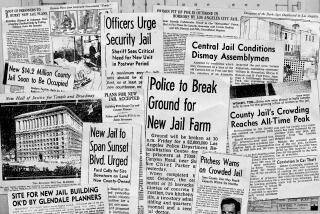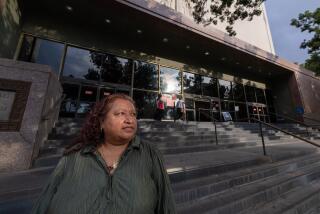Commentary : Jails Become Home for Sick, Dispossessed
- Share via
“Jail, the Modern Mental Institution” reads the title of a recent newsmagazine article. It’s true. The National Assn. of Counties estimated that of the 8 million Americans who went to jail in 1986 for more than 30 days, 600,000, or 13.3%, were severely mentally ill.
In 1984, the American Psychiatric Assn.’s Task Force on the Homeless Mentally Ill published a seminal book, which revealed that about one-third of the chronically, permanently disabled mentally ill in America are homeless. This amounts to about 1 million terribly sick people out on our streets and grates, in our parks and alleys.
These numbers, and the level of barbarism these fellow Americans of ours are experiencing, are startling, and, in the perspective and judgment of history, becoming comparable with the Holocaust. Here, in America.
We are seeing the homeless in our criminal courts by the hundreds and thousands. In 1985, San Diego County Jail Cmdr. Jim Roache estimated that, at any given moment, 15% of our jail’s population was homeless people.
For now, this flow of homeless into our courts has largely dried up because of overcrowded, crisis conditions in our jails. But this doesn’t mean the homeless aren’t having an impact on other elements of the justice system. They are--especially the police. The San Diego Police Department estimates it spends upward of $3 million a year on the problem.
The excellent beat cop, when confronted with a person who is a danger to himself or others because of mental disability or chronic alcoholism, should be able to take that individual (according to state law) to the county’s mental health hospital, to jail or to another facility where the person will be dealt with intelligently.
Today in downtown San Diego, the beat cops have no such resources. As a result, they cannot help but see themselves as engines of a vicious cycle, or “vain acts,” to use the law’s terminology.
Many of the city’s mentally disabled homeless are taken to a jail holding tank for a few hours, sometimes because they “failed to appear” in court for a previous infraction such as spitting on the sidewalk, tossing a cigarette or lodging illegally. Then they are released without ever having seen a judge.
Somebody probably thinks there is some law enforcement logic to this “vain cycle,” but the niceties of due process are surely absent, and we will not retain respect for the law with this revolving-door system.
Also, the downtown beat cops suffer low morale and high burnout rates, and the Police Department bears the cost of high turnover and a high percentage of rookies on the force.
This cycle will continue until the jail overcrowding problem is solved and until San Diego receives its fair share of state mental health funding.
The sales tax increase approved by the voters in June to pay for new jails and courtrooms will help. But passage of Proposition A this November, which would allow the county to participate in a state program to help pay other court costs, is also needed.
But, even once the jails are “normal” again, homeless San Diegans will still be among those seen in our courts--particularly misdemeanor courts--by the hundreds, if the numbers seen in 1983-84 are indicative.
With what have these folks been charged? The huge majority of the offenses are of the trespassing-type: sleeping in the park, on the beach, in a doorway or some other dry-when-raining spot.
(The Rev. Jack E. Lindquist, formerly of First Lutheran Church of San Diego, used to refuse to participate in prosecuting mere “sleepers” . . . reminding us that for at least 500 years, churches have traditionally been sanctuaries where needy folks might find some succor and maybe shelter and gentleness.)
Camping in one’s car is another commonly seen offense, and, of course, we see the prostitutes and the chronic, Skid Row drunks. Very rarely do we see a theft case, and I have been surprised, frankly, at the almost total dearth of shabby homeless defendants being charged with felonies.
I recall one piteous man, into his 60s, his eyes blurry and his intelligent face sad, looking emaciated from starvation, quivering before me. He was charged with second-degree burglary, having been found in a commercial building basement where he had crawled to get warm. It was obvious to me that this man was in court as a result of a “mercy arrest” by the police, who are silently hollering at us in such a case: “Please help this gentleman! Please take notice. Please do the right thing. We have nowhere else to take him!”
The civil courts also see the homeless. About 40% of the 24,000 civil filings in San Diego are landlord-versus-tenant unlawful-detainer cases. The subject is eviction, and, for some, this court appearance--or sadly, default judgment as happens in 85% of such cases--is the “last stop before the streets” for the hapless defendants.
As one who handled the bulk of this portion of the civil calendar for a year, I saw many people who had been disabled--by recent surgery, loss of limbs, military action, mental illness, alcoholism and drug abuse, marginal intelligence or a combination of these--tossed out on their ears.
Not infrequently, this ejection was from federally subsidized housing, which is specifically designed to serve the most disabled of our populations. Sometimes it involved parents with children, sometimes disabled parents with children. Usually these innocent souls had not the vaguest idea of the brutality they were about to encounter on our city’s mean streets.
These folks, of course, become financially costly to society, burdening the justice system along with the other elements of society’s tattered human care infrastructure.
Their children, who are monstrously terrified and brutalized by life on the streets, represent the community’s and the nation’s future. It would clearly be in the interest of prudence as well as justice to prevent these people’s entry into the ranks of the homeless.
How?
Well, this judge often found himself back in chambers after ordering such an eviction, on the telephone calling shelters, “emergency specialists,” social workers and fellow Rotarians to finding avenues to new housing. Landlords’ attorneys often pitched in, sometimes taking preventive action so that dozens of cases never made their way to court. Legal Aid and other tenant counselors learned that this had become part of their fiduciary duty to improve their clients’ lot.
Ultimately, the 1.2 million lowest-income housing units destroyed in America over the past eight years must be replaced and a viable national housing policy reinstituted.
In the meantime, we locals must determinedly do our ethical, professional and human duties as brilliantly and practically as we can--with the tools at hand in each circumstance.
We must also labor to create better tools--lest our beloved justice systems devolve into a series of “vain acts,” which will make us laughingstocks and destroy the basis of civil society in respect for the law.
More to Read
Sign up for Essential California
The most important California stories and recommendations in your inbox every morning.
You may occasionally receive promotional content from the Los Angeles Times.










